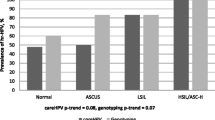Abstract
Human papillomavirus (HPV) is a major cause of cervical neoplasia development. HPV screening is very important because early treatment can prevent cervical cancer. Omniplex-HPV is a polymerase chain reaction followed by Luminex xMAP bead microarray technology that is designed for detecting 40 HPV genotypes. The aim of this study is to evaluate the analytical and clinical performance of the Omniplex-HPV in comparison with that of the commercially available RFMP (restriction fragment mass polymorphism) HPV PapilloTyper. A total of 2,808 cervical swab specimens were obtained. Of these, only 1799 specimens had a cytology result. A type-specific direct sequencing test was performed using the reference method in case of discrepancies between the two test results. The overall percent agreement (OPA) between Omniplex-HPV and RFMP HPV PapilloTyper was 97.9% (κ=0.84; 95% CI: 0.81-0.88). The positive percent agreement (PPA) and the negative percent agreement (NPA) were 98.0% and 96.2%, respectively. The Omniplex-HPV and RFMP HPV PapilloTyper showed comparable sensitivities (90.2% and 91.9%, respectively) and specificities (91.3% each), while the Omniplex-HPV produced more accurate results and required less turnaround time and labor. The agreement between these two methods was excellent for HPV genotyping (P>0.05; McNemar’s test), and clinical sensitivity, specificity, and odds ratio of the two assays were comparable to the result of cytology tests in identifying high risk HPV. In conclusion, Omniplex-HPV and RFMP HPV PapilloTyper were highly comparable with regard to detection and genotyping analysis of HPV.
Similar content being viewed by others
References
Oh CM, Won YJ, Jung KW, Kong HJ, Cho H, Lee JK et al (2016) Cancer statistics in Korea: incidence, mortality, survival, and prevalence in 2013. Cancer Res Treat 48:436–450
Walboomers JM, Jacobs MV, Manos MM, Bosch FX, Kummer JA, Shah KV et al (1999) Human papillomavirus is a necessary cause of invasive cervical cancer worldwide. J Pathol 189:12–19
Tilston P (1997) Anal human papillomavirus and anal cancer. J Clin Pathol 50:625–634
Poljak M, Kocjan BJ, Ostrbenk A, Seme K (2016) Commercially available molecular tests for human papillomaviruses (HPV): 2015 update. J Clin Virol 76(Suppl 1):S3–S13
Min KJ, Lee YJ, Suh M, Yoo CW, Lim MC, Choi J et al (2015) The Korean guideline for cervical cancer screening. J Gynecol Oncol 26:232–239
Smith RA, Manassaram-Baptiste D, Brooks D, Doroshenk M, Fedewa S, Saslow D et al (2015) Cancer screening in the United States, 2015: a review of current American cancer society guidelines and current issues in cancer screening. CA Cancer J Clin 65:30–54
Solomon D, Davey D, Kurman R, Moriarty A, O’Connor D, Prey M et al (2002) The 2001 Bethesda system: terminology for reporting results of cervical cytology. JAMA 287:2114–2119
Bouvard V, Baan R, Straif K, Grosse Y, Secretan B, El Ghissassi F et al (2009) A review of human carcinogens—part B: biological agents. Lancet Oncol 10:321–322
Munoz N, Bosch FX, de Sanjose S, Herrero R, Castellsague X, Shah KV et al (2003) Epidemiologic classification of human papillomavirus types associated with cervical cancer. N Engl J Med 348:518–527
Lee HP, Kim SO, Hwang TS, Bae JM, Kim SN, Kim JW et al (2011) Analytical and clinical performances of a restriction fragment mass polymorphism assay for detection and genotyping of a wide spectrum of human papillomaviruses. J Med Virol 83:471–482
Yu S, Kwon MJ, Lee EH, Park H, Woo HY (2015) Comparison of clinical performances among Roche Cobas HPV, RFMP HPV PapilloTyper and Hybrid Capture 2 assays for detection of high-risk types of human papillomavirus. J Med Virol 87:1587–1593
Gravitt PE, Peyton CL, Alessi TQ, Wheeler CM, Coutlee F, Hildesheim A et al (2000) Improved amplification of genital human papillomaviruses. J Clin Microbiol 38:357–361
Chung HJ, Kim SN, Lee EH, Jee MS, Kim MA, Hwang SY et al (2006) Comparison of efficacy of human papilloma virus genotyping assays using restriction fragment mass polymorphism and DNA chip analysis in patients with abnormal pap smear and uterine cervical cancer. Korean J Pathol 40:439–447
Lee HP, Cho W, Bae JM, Shin JY, Shin SK, Hwang SY et al (2013) Comparison of the clinical performance of restriction fragment mass polymorphism (RFMP) and Roche linear array HPV test assays for HPV detection and genotyping. J Clin Virol 57:130–135
Asato T, Maehama T, Nagai Y, Kanazawa K, Uezato H, Kariya K (2004) A large case-control study of cervical cancer risk associated with human papillomavirus infection in Japan, by nucleotide sequencing-based genotyping. J Infect Dis 189:1829–1832
Vernon SD, Unger ER, Williams D (2000) Comparison of human papillomavirus detection and typing by cycle sequencing, line blotting, and hybrid capture. J Clin Microbiol 38:651–655
Chung MY, Kim YW, Bae SM, Kwon EH, Chaturvedi PK, Battogtokh G et al (2012) Development of a bead-based multiplex genotyping method for diagnostic characterization of HPV infection. PLoS One 7:e32259
Peng J, Gao L, Guo J, Wang T, Wang L, Yao Q et al (2013) Type-specific detection of 30 oncogenic human papillomaviruses by genotyping both E6 and L1 genes. J Clin Microbiol 51:402–408
Moss EL, Moran A, Douce G, Parkes J, Todd RW, Redman CW (2010) Cervical cytology/histology discrepancy: a 4-year review of patient outcome. Cytopathology 21:389–394
Author information
Authors and Affiliations
Corresponding author
Ethics declarations
The study was funded by Genematrix Inc. which is the company producing both HPV-assays, therefore this should be stated as a conflict of interest.
Additional information
Handling Editor: Martin Schwemmle.
Electronic supplementary material
Below is the link to the electronic supplementary material.
Rights and permissions
About this article
Cite this article
Yoon, Y.A., Kim, BH., Heo, SH. et al. Comparative evaluation of the Omniplex-HPV and RFMP HPV PapilloTyper for detecting human papillomavirus genotypes in cervical specimens. Arch Virol 163, 969–976 (2018). https://doi.org/10.1007/s00705-017-3687-4
Received:
Accepted:
Published:
Issue Date:
DOI: https://doi.org/10.1007/s00705-017-3687-4




